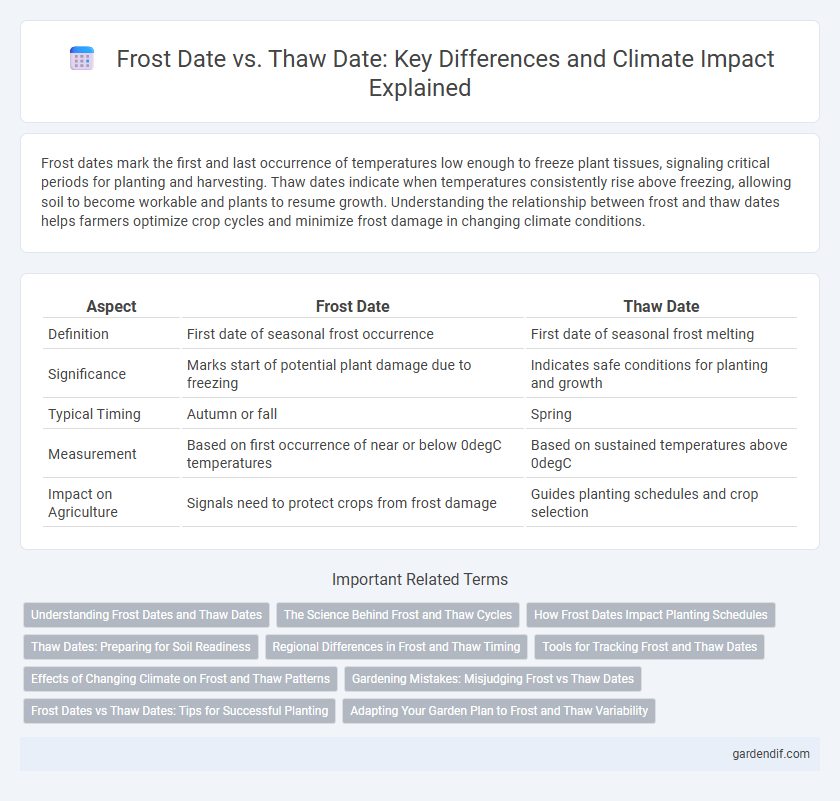
Frost Date vs Thaw Date Illustration
Frost dates mark the first and last occurrence of temperatures low enough to freeze plant tissues, signaling critical periods for planting and harvesting. Thaw dates indicate when temperatures consistently rise above freezing, allowing soil to become workable and plants to resume growth. Understanding the relationship between frost and thaw dates helps farmers optimize crop cycles and minimize frost damage in changing climate conditions.
Table of Comparison
| Aspect | Frost Date | Thaw Date |
|---|---|---|
| Definition | First date of seasonal frost occurrence | First date of seasonal frost melting |
| Significance | Marks start of potential plant damage due to freezing | Indicates safe conditions for planting and growth |
| Typical Timing | Autumn or fall | Spring |
| Measurement | Based on first occurrence of near or below 0degC temperatures | Based on sustained temperatures above 0degC |
| Impact on Agriculture | Signals need to protect crops from frost damage | Guides planting schedules and crop selection |
Understanding Frost Dates and Thaw Dates
Frost dates mark the average first and last occurrence of frost in a region, crucial for determining safe planting periods to prevent crop damage. Thaw dates indicate when accumulated snow and ice begin to melt, signaling the onset of the growing season and impacting soil temperature and moisture levels. Monitoring these dates helps farmers and gardeners optimize planting schedules and protect sensitive plants from frost harm.
The Science Behind Frost and Thaw Cycles
Frost date and thaw date mark critical points in the annual temperature cycle governed by the Earth's tilt and solar radiation. Frost forms when surface temperatures drop below 0degC, causing water vapor to freeze on plants and soil, while thaw occurs as rising temperatures return the ground and air above freezing. These cycles influence growing seasons, crop viability, and ecosystem dynamics by regulating the period between the first frost in autumn and the final thaw in spring.
How Frost Dates Impact Planting Schedules
Frost dates mark the average last occurrence of frost in spring and the first in fall, critically shaping optimal planting schedules by signaling when soil temperatures become safe for seed germination. Early frost dates in fall can shorten the growing season, risking crop damage, while late spring frost dates delay planting and reduce growth periods. Understanding regional frost date patterns helps farmers minimize frost-related crop losses and maximize yields through precise timing of planting activities.
Thaw Dates: Preparing for Soil Readiness
Thaw dates mark the period when soil temperatures rise above freezing, signaling optimal conditions for planting and soil preparation. Understanding local thaw dates helps farmers and gardeners schedule tilling and planting to avoid soil compaction and promote seed germination. Accurate tracking of thaw dates supports effective crop management by aligning agricultural activities with natural soil readiness.
Regional Differences in Frost and Thaw Timing
Frost date and thaw date vary significantly across regions due to differences in latitude, altitude, and local climate conditions. Northern and high-elevation areas experience later thaw dates and earlier frost dates, leading to shorter growing seasons compared to southern and lowland regions. Coastal regions often have milder frost and thaw timings influenced by maritime climate effects, resulting in less extreme temperature fluctuations.
Tools for Tracking Frost and Thaw Dates
Digital weather stations and soil temperature sensors provide precise monitoring of frost and thaw dates, enabling timely agricultural decisions. Mobile apps integrated with local climate data offer real-time alerts for frost onset and thaw periods, enhancing crop protection strategies. Historical frost and thaw date databases support predictive modeling, improving long-term climate adaptation planning.
Effects of Changing Climate on Frost and Thaw Patterns
Rising global temperatures cause earlier thaw dates and delayed frost dates, resulting in longer growing seasons and altered ecosystem dynamics. These shifts disrupt plant phenology, increasing vulnerability to late frosts and affecting agricultural productivity. Changes in frost and thaw patterns also impact soil moisture and carbon cycling, influencing climate feedback mechanisms.
Gardening Mistakes: Misjudging Frost vs Thaw Dates
Misjudging frost and thaw dates leads to mistimed planting that can damage young plants or reduce yields. Frost dates mark the last expected frost in spring or first frost in fall, critical for avoiding frostbite on tender seedlings. Thaw dates indicate when soil and temperatures stabilize above freezing, ensuring roots can establish without stress; confusing the two risks premature exposure or delayed growth.
Frost Dates vs Thaw Dates: Tips for Successful Planting
Frost dates mark the average first and last occurrence of frost in a region, crucial for determining safe planting windows to avoid cold damage. Thaw dates indicate when soil temperatures consistently rise above freezing, signaling optimal conditions for seed germination and root establishment. Understanding local frost and thaw dates helps gardeners time planting to maximize crop success and minimize frost-related risks.
Adapting Your Garden Plan to Frost and Thaw Variability
Understanding frost date and thaw date variability is crucial for optimizing planting schedules and protecting sensitive crops from unexpected temperature fluctuations. Gardeners should monitor local climate data and use frost-resistant plant varieties to minimize damage during unpredictable frost events. Incorporating season extenders like row covers or cold frames can enhance garden resilience by mitigating risks associated with early frost or delayed thaw periods.
Frost Date vs Thaw Date Infographic

 gardendif.com
gardendif.com